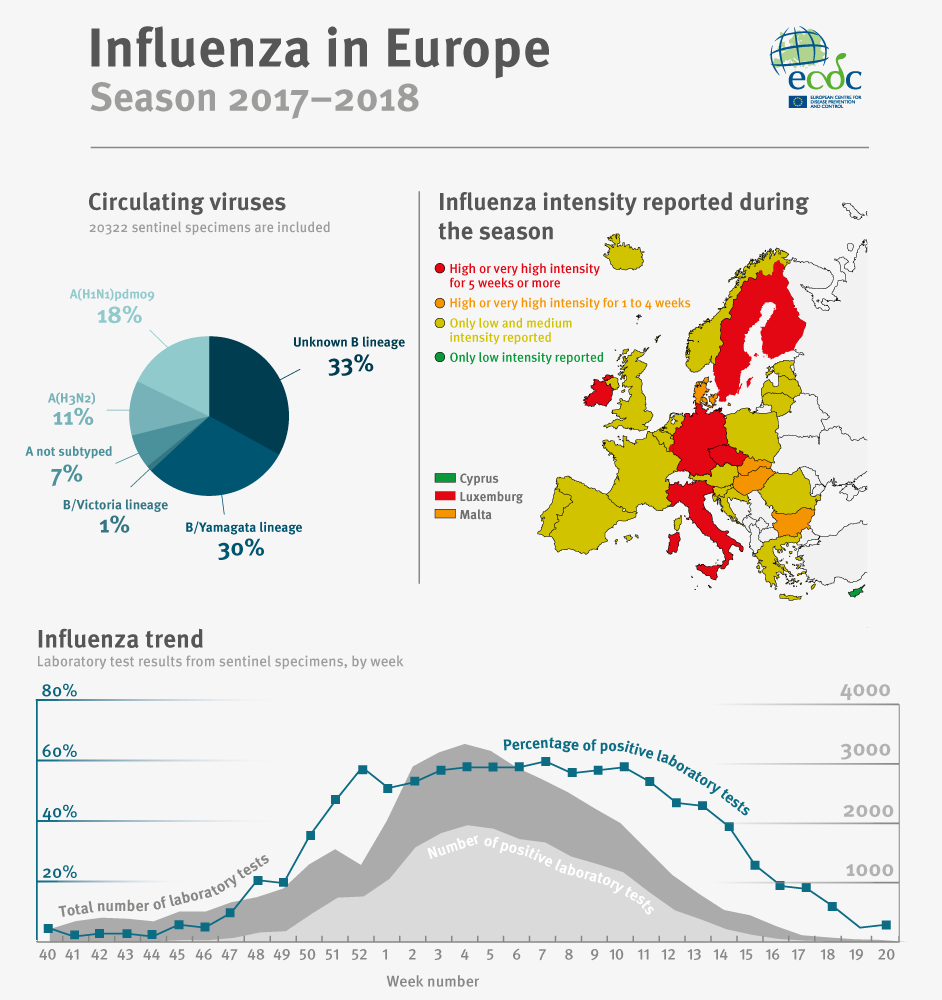Influenza in Europe, summary of the season 2017–18

Influenza activity started in week 47/2017 and returned to baseline levels in week 18/2018. In northern and south-western Europe (EU/EEA) , the activity started to increase between mid-December and early January, similar to the timing of the 2016–2017 season but earlier than in the previous five seasons.
The peak in activity was in early January in south-western Europe and in mid-February 2018 in northern Europe (EU/EEA). In some countries in Eastern Europe, influenza activity did not peak until mid- to late March.
The majority of influenza viruses detected were of type B, representing a higher level of circulation of influenza B viruses compared to recent seasons. Of all subtyped influenza B viruses detected in sentinel samples, 97% were B/Yamagata and 3% were B/Victoria viruses. Both influenza A subtypes, A(H3N2) and A(H1N1)pdm09 co-circulated in the region. Of all subtyped A viruses detected in sentinel samples, 38% were A(H3N2) viruses and 62% were A(H1N1)pdm09 viruses.
Influenza viruses circulated at high levels between weeks 51/2017 and 13/2018. This is longer than in recent seasons and may have contributed to the high severity of the 2017/18 season. Especially influenza B activity was detected for a longer period of the season and at a greater magnitude than in the previous seasons. Severe cases were observed in hospital settings due to B virus, but also due to A(H3N2) and A(H1N1)pdm09 viruses. Overall, the majority of severe cases were due to influenza virus type B infection and mostly were persons 40 years of age or older. Patients in intensive care units were mostly infected by influenza type A virus.
Overall, excess mortality from all causes was reported by the majority of 21 reporting countries during the influenza season and was mainly observed in people aged 65 years or older.
Download the Infographic
Annual epidemiological report
Scientific and technical publications
Seasonal influenza - Annual Epidemiological Report for 2017 - 2018
During the 2017–2018 season, 41 315 specimens from sentinel primary care providers were tested for influenza, 22% more than in the previous season; 49% of the specimens were positive for influenza virus (previous season: 40%).
ECDC key updates
The main surveillance and virological outputs as well as articles on the vaccine vaccine effectiveness for the season is listed below.
All updates from ECDC and key partners on surveillance data and other developments for the influenza 2017-2018 season is also available via a Twitter moment.




